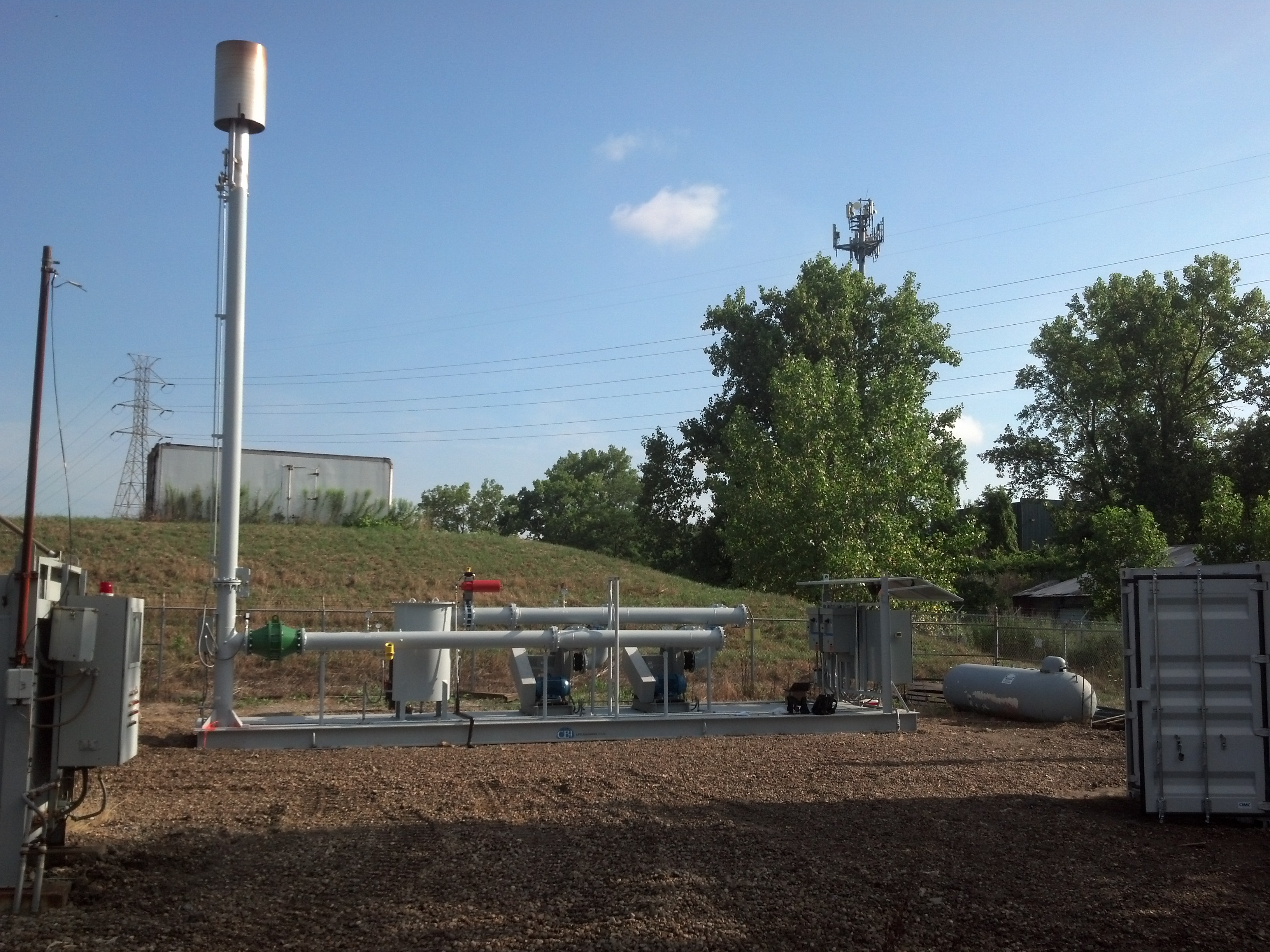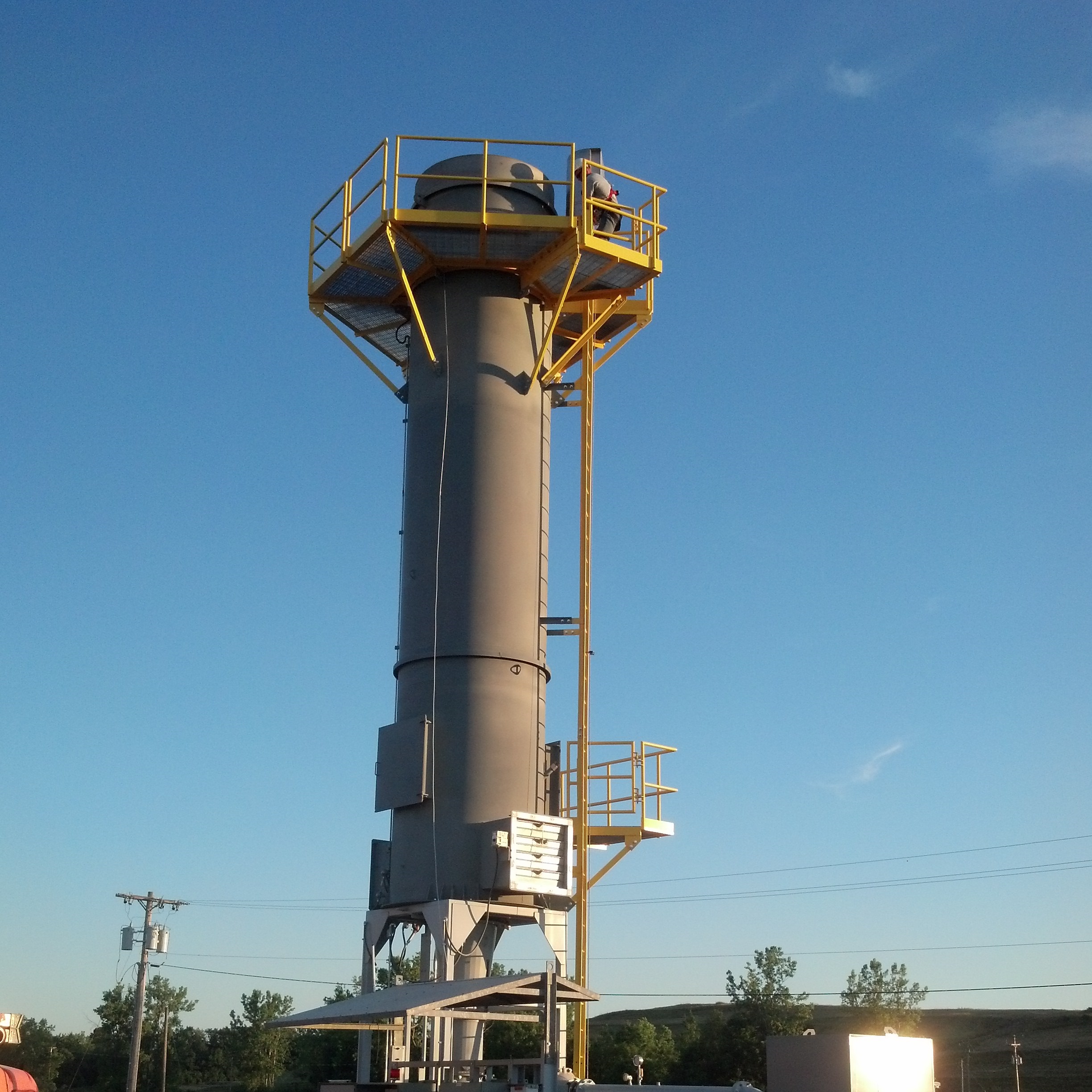Utility Flare

This type of flare has an open burner set at sufficient elevation to limit the amount of radiated heat that reaches the ground. They have good combustion efficiency but all other types flare have verifiable and better destruction efficiency.
Due to open combustion this type of flare is difficult to accurately measure emissions and determine destruction efficiency.
The greatest advantage to these flares are the low price and maintenance as compared to other types of flares.
Some other names for this type of flare are...
Elevated, Candle Stick and Open Flare
Utility flares give the best destruction efficiency and lowest cost of ownership for the price.
Flare Guy
Qualities
Simplest of landfill gas flares
Low maintenance
Smallest equipment footprint
Lowest cost of landfill gas flares
Passive operation, nearly no energy consumption for burner operation
Good destruction efficiency but lower than other technologies
Preferred technology when strict emission are not a requirement
Cannot directly measure emissions
Open / Visible flame
Must consider proximity to power lines and buildings
Enclosed Flare

This style of flare stack encloses the combustor and incorporates air dampers.
Enclosing the combustion process retains heat from burning landfill gas affording additional time to destroy combustion byproducts. Draft is induced by the difference in air pressure from the top to bottom of the stack. Dampers are included providing a method for stack air regulation.
Heat is released in the reaction between oxygen in air and methane in landfill gas results in a rise of temperature for the components retained in the stack. Constituents created during combustion are dependent on the temperature and oxygen present at the time reaction occurs. Adjustment of the dampers allow combustion temperature regulation, determining emission from the stack.
Destruction efficiency is improved by retention of combustion byproducts in the heat zone created by the stack. In addition to retention time stack exhaust can be sampled for emission verification. Flares from this family can provide destruction efficiency up to 99.9% with reasonable NOX and CO emissions.
The empirical operating point for flares of this class is 1650°F (900°C). Combustion of landfill gas at this temperature provides the lowest emissions between CO and NOX, emission that have an important impact on air quality.
Excess air is used to control stack temperature and temperature determines emission spectrum. Reduced excess air (hotter stack) CO decreases and NOX increases, increase air (cooler stack) the NOX is down and CO goes up. Some variation in nominal set point of 1650°F is likely due to emission requirements, flare burner performance, measurement technique, measurement location and electronics accuracy. Therefore, emission testing is required to confirm the correct temperature set point to obtain the desired emission.
Enclosed flares provide the best performance to minimize NOX and CO for the price.
Flare Guy
Qualities
No visible flame / smoke
Verifiable emissions
Low energy consumption for burner operation
Controllable emission spectrum within the performance of the burner
Added complexity for air damper control
Emission quality is dependent on flame position, control loop tuning / temperature stability
Moderate cost
Larger footprint than utility flares
Ultra-Low Emission Flares

This class of landfill gas flares offer the lowest emissions and greatest destruction efficiency at the cost of energy consumption, sophisticated control algorithms and complex burner design.
Low emission flares utilize forced draft to insure tight control of the oxidizer for the fuel. Forced draft use an air blower to deliver combustion air. Air and landfill gas are introduced to a vessel for mixing, insuring a homogenous mix at the burner. The burner nozzle provides a final point of mixing to insure the best possible mix of air and fuel prior to combustion.
Although air is tightly controlled during the premix the burner is not perfect and some hydrocarbons may escape complete combustion at the burner. Post combustion gases are hot and retained in the stack to afforded additional time to oxidize anything that escaped break down during primary combustion.
Secondary air is introduced at the stack of the low emission flare in the same way a natural draft enclosed flare receives air. Secondary air controlled by dampers set stack temperature, determines reaction energy and emission spectrum, ensures combustion of any fuel that escaped complete combustion at the burner. Regulating stack temperature has the added benefit of extended insulation life.
Another consideration to be made is premixed fuel and air are ready to combustion and can result in an explosion if not properly handled. To better manage risk the amount of premixed fuel should be kept to the smallest amount possible and combusted shortly after mixing. Where possible do not hold or retain premix fuel in a large vessel. Accidental ignition of significant volumes of premixed air and fuel may lead to an explosive rupture of the vessel, damage nearby equipment and severely injure personnel.
Ultra-Low Emission Flares offer the best performance under the most stringent regulatory requirements at the expense of energy consumption, equipment cost, complexity and maintenance.
Flare Guy
Qualities
Lowest emission
Highest destruction efficiency
Highest energy consumption
Greatest complexity
Greater maintenance cost
Largest equipment foot print
Highest price